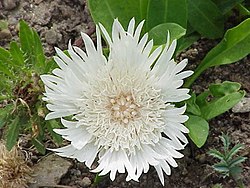| Stokesia laevis | |
|---|---|
 | |
| Scientific classification | |
| Kingdom: | Plantae |
| Clade: | Tracheophytes |
| Clade: | Angiosperms |
| Clade: | Eudicots |
| Clade: | Asterids |
| Order: | Asterales |
| Family: | Asteraceae |
| Subfamily: | Vernonioideae |
| Tribe: | Vernonieae |
| Genus: | Stokesia L'Hér. |
| Species: | S. laevis |
| Binomial name | |
| Stokesia laevis (Hill) Greene | |
| Synonyms | |
Carthamus laevis [2] | |
Stokesia is a monotypic genus of flowering plants in the daisy family, Asteraceae, containing the single species Stokesia laevis. Common names include Stokes' aster and stokesia. [3] [1] The species is native to the southeastern United States.
The flowers appear in the summer and are purple, blue, or white in the wild. [2] The plant is cultivated as a garden flower. Several cultivars are available, including the cornflower blue 'Klaus Jelitto', 'Colorwheel', which is white, turning purple over time, and 'Blue Danube', which has a blue flower head with a white center. [4] More unusual cultivars include the pink-flowered 'Rosea' and yellow-flowered 'Mary Gregory'. [5]
Like a few other plants (such as some species of Vernonia ), it contains vernolic acid, a vegetable oil with commercial applications. [6]
The genus is named after Jonathan Stokes (1755–1831), English botanist and physician. [2]
